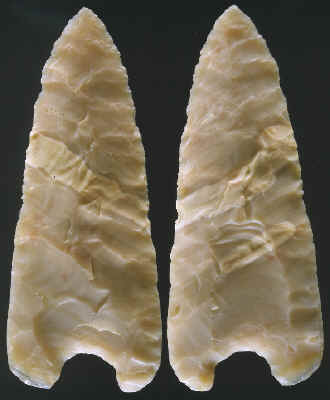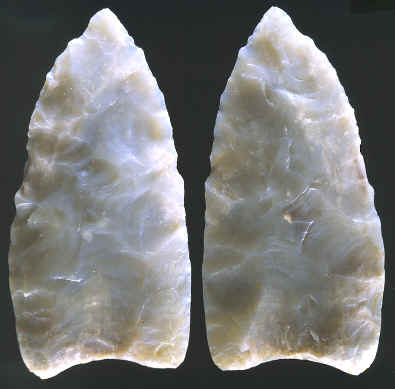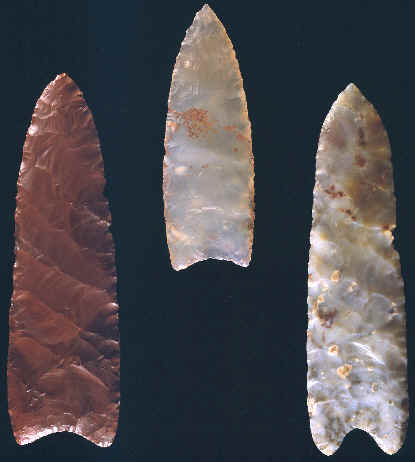The three Clovis points
in the lower left corner in this picture were all found on the Colby
mammoth kill site. Other artifacts in this picture are from the Anzick
cache site in Montana, the Domebo mammoth kill site in Oklahoma, the Fenn
cache site in Utah, a point found near the Dietz site in Washington
state, the Blackwater Draw kill site in Colorado and a Clovis point
found on the surface in Utah. The large biface core in the center is the
largest complete Clovis artifact made of stone discovered to date.
This is the largest complete Clovis point found on the Colby
mammoth kill site. It was found by Donald Colby in 1962
while using heavy
earth moving equipment during the construction of a reservoir. It's made
of banded chert from the Madison Formation and it measures 3 11/16
inches (93mm) long.
This Clovis point was found during the 1975 excavation. It was found in bone pile number 2 below a row of ribs. This point also has the "Colby style base" which is a base that is more rounded and a concavity that is becoming almost "notched". If the concave area was more uniformly flaked all the way to both edges it would look more like a typical Clovis point. This point was probably resharpened at least one or more times. It is made of a dark red Phosphoria Formation chert and measures 2 3/16 inches (56mm) long.
This Clovis point was found during the excavation of bone pile number 1 near one of the ribs. It's a good representative example of a "classic" style Clovis point. The base on this point is not as rounded and the concavity is shallow & not deeply notched as are the three other examples found on this site. Both hinge fractures at the end of the channel flakes were removed by percussion flakes. The heavily ground basal edges are also more parallel than the other points that have more rounded or tapered basal edges. This point is made of a translucent Phosphoria Formation chert and measures 2 1/2 inches (61mm) long.
Here is another example of the variation of Clovis basal styles from a
single site. These three points are part of what has become known as the Fenn cache and they are believed to have been found together as a single
group. But there is still a difference in style just as there is in the
points found on the Colby site. One of these points has a base which was
made very similar to the "classic" Colby notched bases. It has
the same rounded wide "ears" and a very deep concave base. |
|
|
"REFERENCES"
|
|




